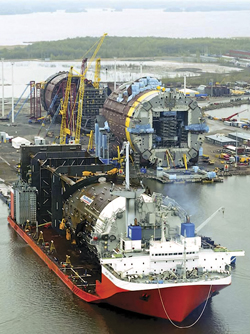Vol. 233 No. 11
It’s the economy…and more
|
.jpg)
|
“It's the economy, stupid!”
-James Carville, campaign strategist for Bill Clinton, during the 1992 U.S. presidential campaign.
In the course of global economic history, markets shift when goods and services can be acquired at a lower price. A good example is the textile industry. Since medieval times, textile weavers in Dhaka (now part of Bangladesh) produced the world’s finest muslin. As late as 1817, Dhaka muslin sold at a 75% profit in London. But the Dhaka textile business was decimated by the industrial revolution and the mass production of cotton textiles from the mills in Birmingham, England. A century later, the market shifted once again to the Far East, with the production of synthetic textiles in China and India.
In the oil and gas industry, a similar shift has occurred in the shipyard sector. During the 19th century, the Harland & Wolff shipyard in Belfast, Northern Ireland, built many of the great passenger liners, including the ill-fated Titanic. As of 2011, the H&W shipyard is making a return with the offshore wind power business. However, the bulk of the oilfield marine structures, including drillships and semisubmersibles, are built in the Far East. South Korea has the largest market share at 37%, followed by China and Japan.
Ironically, China’s Ming Empire had sent out seven gigantic naval expeditions under the command of Admiral Zheng He, starting in 1403. Zheng He’s ships were five times the size of Christopher Columbus’ flagship vessel, the Santa Maria. Unfortunately, China retreated behind the bamboo curtain in 1433, with no further shipbuilding and no sea faring voyages.
A special exception to the economic flight of the oilfield shipyard sector to the Far East is Technip’s shipyard in Pori, Finland. In a country that has no oil and gas production, and not even source rocks worthy of a petroleum geologist’s time and effort, Technip has built 14 of the world’s 17 spar platforms in the Pori shipyard. The last one was the Perdido, which is currently operating for Shell in the Gulf of Mexico at a world-record 7,817-ft water depth. The 15th spar, Lucius for Anadarko, is under construction. At this time, the shipyard has completed three of the five Luicius hard-tank sections. Next on the assembly line is the Aasta Hansteen spar for Statoil, the first spar in Norwegian waters and the largest ever built with a total hull length of 195 m.
Pori’s deep harbor in the Baltic Sea is ideal for a shipyard—away from the rough North Sea gales, hurricanes in the Gulf of Mexico and typhoons in the Far East. Tom Ayers, Technip V.P. for Offshore Projects - North America, revealed during a recent press tour that the waterfront has no tides, making it easier during the loadout of a structure onto a barge. While labor rates in Finland might be high relative to the Far East, one of the incentives in favor of Pori is that the shipyard has delivered all the spars on time and within budget. The cost budget is met in spite of the fact that the Pori shipyard sources its steel for spar fabrication from Finnish mills. Another factor important to Technip and the operators is the excellent HS&E record at the shipyard. The total recordable incident frequency in 2012, thus far, is 0.69. To be sure, all of these factors can result in a reduced cost for the overall project.
 |
| Technip’s shipyard in Pori, Finland, has become an assembly line for spars. |
|
Pori shipyard is a center of excellence within Technip for arc welding. When the Kikeh spar was built in Malaysia in 2006, due to that country’s high local labor content requirements, Technip had to build a sauna for its 40 Finnish welders. With the discovery of the massive pre-salt fields in deepwater Brazil, there is now high demand for offshore drilling and production platforms there. If Petrobras and its partners select a spar platform for a future field, Technip will be well advised to build a string of saunas next to the Copacabana and Ipanema beaches.
Pori is a great example of how on-time delivery, under budget, of technologically intensive products can trump basic economics. There’s nothing stupid about that—a success story that even James Carville can appreciate. 
|

.jpg)


